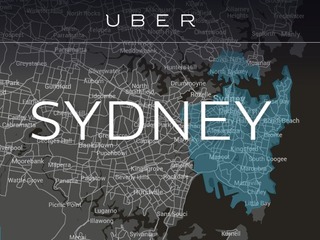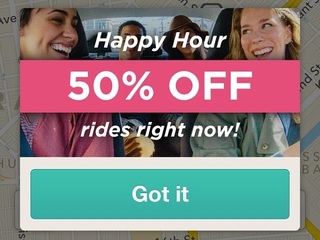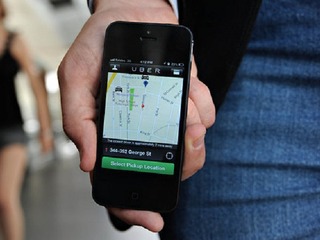Credentialing automation platform Baton Health launches Universal Primary Source database
That gives its customers access to hundreds of PSV databases through a single query
Read more...

You have to hand it to Uber: even in the face of withering criticism, the company never backs down.
Price surging, or jacking up rates during peaking times, has been one of the most controversial aspects of the business. People have railed against the practice for years. It all came to a head earlier this week the company was blasted for increasing prices in Sydney during a horrific hostage crisis that ultimately left multiple people dead.
And yet now Uber is it has come out, via a report out from Bloomberg, that Uber looking to patent the practice. Like I said, this is not a company that backs down.
The patent, number 20130246207 A1, is for a "System and method for dynamically adjusting prices for services." The actual patent was discovered by Quartz. What it does is try to use economics of supply and demand to determine if prices should increase.
"A price, relative to a default price, for using the service provided by one or more service providers is adjusted based on the determined amount of requesters and the determined amount of available service providers," the patent says.
It also allows for how such information will be relayed to the person requesting the ride.
"Pricing data corresponding to the adjusted price is transmitted to one or more requesting devices or one or more provider devices so that the adjusted price can be displayed on at least one of the one or more requesting devices or the one or more provider devices and be indicative of an adjustment in price as compared to the default price."
Uber, however, wants to go beyond just how many people are requesting a ride at that moment. It also wants to use historical data from similar dates and times to see if a surge would be warranted.
"The historical data (141) that is used by the price adjustment (150) can be data that is comparable to the given time. For example, if the price adjustment (150) is configured to make an adjustment on a holiday, such as at night at 9 pm on Halloween (October 31), the price adjustment (150) can use historical data (141) that is comparable to previous Halloweens (e.g., data from Halloween for the last three years, or the last five years) that were provided by requesting devices (170) and provider devices (180) around the same time (e.g., night). The price adjustment (150) can also use historical data (141) that in a more specific manner, for example, by using historical data (141) that corresponds to data received at 9 pm every night for the past month."
Also being factored in are what it is calling "outside sources," which can be holidays, weather, information from social media, flight information from airports and, yes, even emergencies, though Uber might want to tread lightly in those situations.
In Sydney this week some even reported fares going up as high as four times the usual rate, according to Mashable. A ride from the area to the airport cost some passengers between $145 and $185, for a ride that would normally cost $100. Eventually the backlash forced Uber to offer refunds and start giving out free rides.
The damage was already done, though, and the message to Uber was clear: just because you can surge prices, doesn't mean you always should.
Price surging
Uber's price surging has always been a controversial topic, but CEO Travis Kalanick has repeatedly defended the practice, and explained it as a necessary evil for Uber to be able to compete.
In two blog posts, he has made it clear why he feels the increased pricing is necessary during peak times.
"We raise price when supply of available cars gets tight," he said. "We raise the price in increments over time based on supply health. When supply opens up, we then lower the price."
The reason it is necessary, he has said, is because raising the price gets more drivers out, which is more important during high demand periods like New Year's Ever.
"Higher prices encourages more supply to come online. It gets some drivers out to work on NYE. It keeps other drivers from going to alternatives like renting their car out for the night, or trying their luck at hustling rides on the street," he said. "Higher prices means more cars, means more rides, means more people getting around the city efficiently, safely AND in style."
Essentially, the way Kalanick sees it, it is necessary to charge more to get more drivers to be willing to go out. From my perspective, this seems a little specious when talking about a time like New Year's Eve, a night when every driver knows that there will be a lot of money to be made, no matter what the fare.
Kalanick, though, counters that by saying that drivers have plenty of options, so Uber needs to give them a reason to stick them.
"Drivers have alternatives to make a lot of money on this night, and if we do nothing, they’ll go elsewhere," he said. "Our driver ops guys worked their butts off the week before NYE trying to get as many drivers as humanly possible to take the Uber bet on NYE—it's a tough bet as one of their alternatives is selling their services for $1500 or more for the night."
The times when it would seem to more likely increase the number of drivers on the road would be during bad weather, especially heavy snowfall, when many drivers would, obviously, think twice about whether it would be worth driving in. During those times it is understandable to give drivers an extra incentive to do business.
Uber had no further comment on the patent.
(Image source: businessinsider.com)
That gives its customers access to hundreds of PSV databases through a single query
Read more...The company plans to bring its device to market in Europe before expanding to the United States
Read more...Talkspace will be the therapy partner for femtech brand Nurx and migraine treatment platform Cove
Read more...Startup/Business
Joined Vator on
Uber is a ridesharing service headquartered in San Francisco, United States, which operates in multiple international cities. The company uses a smartphone application to arrange rides between riders and drivers.


